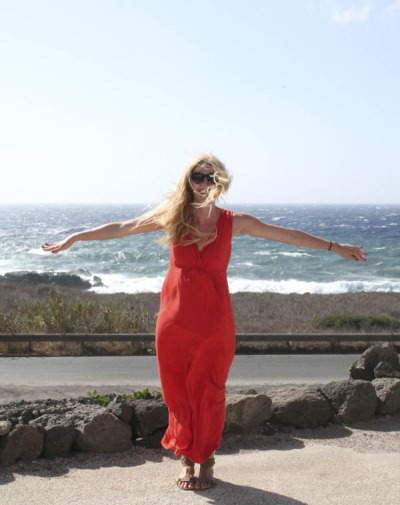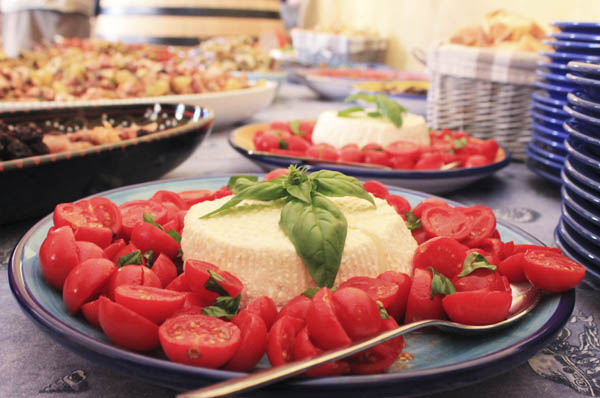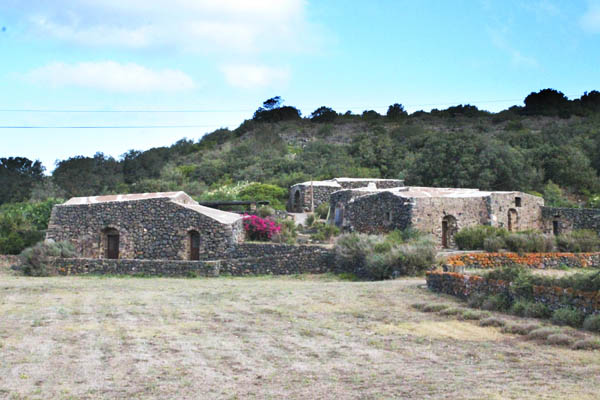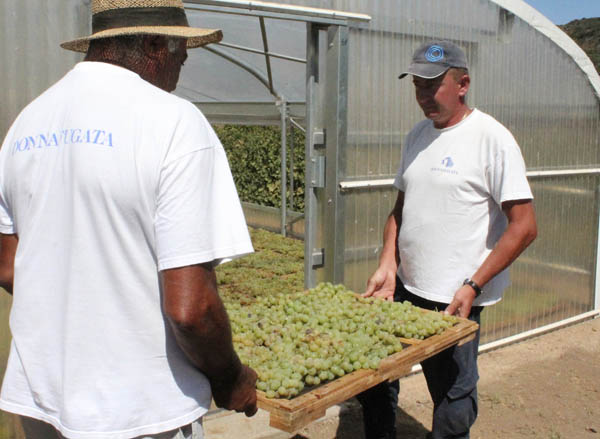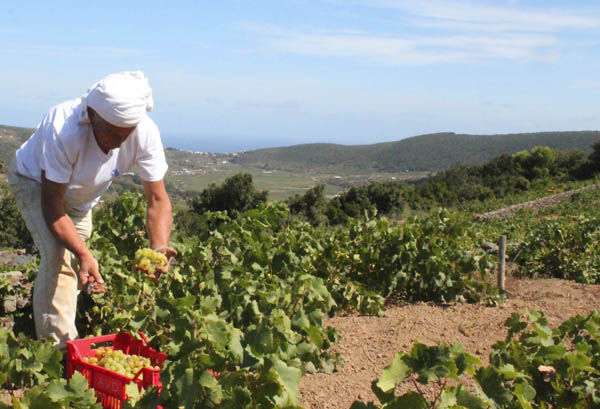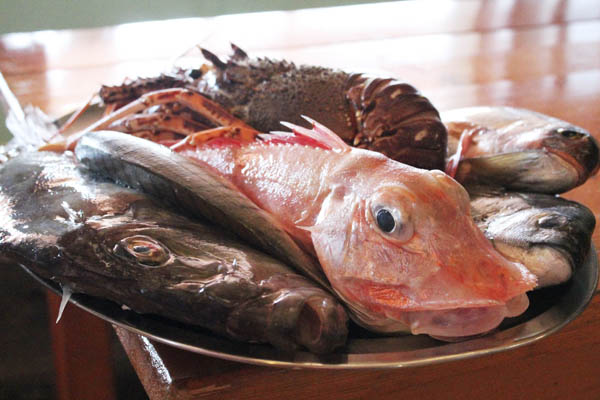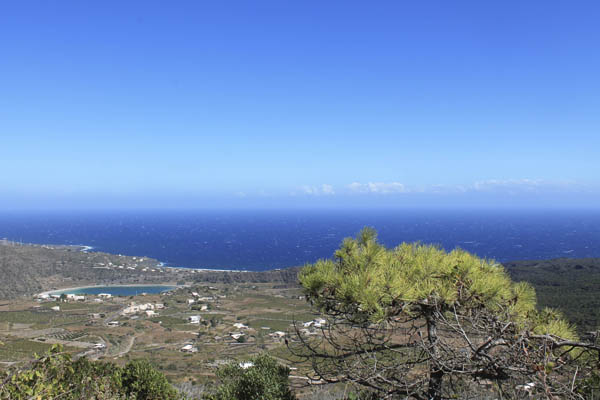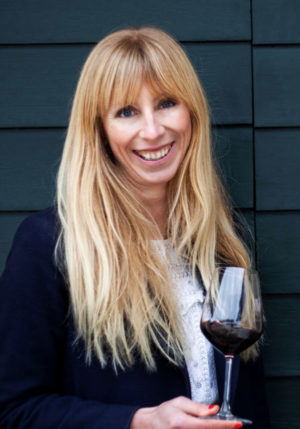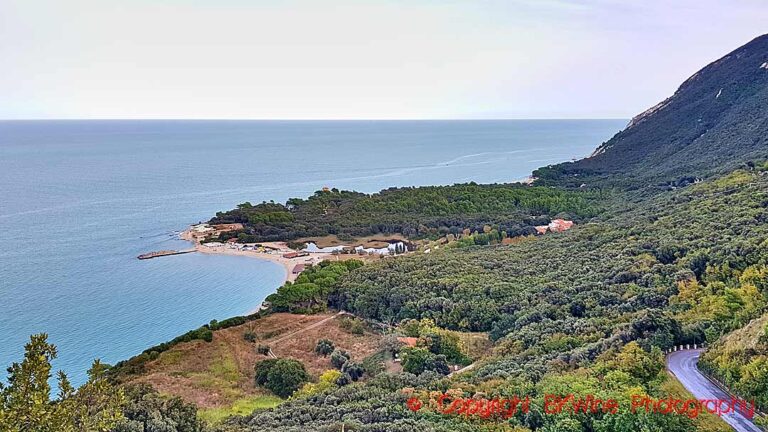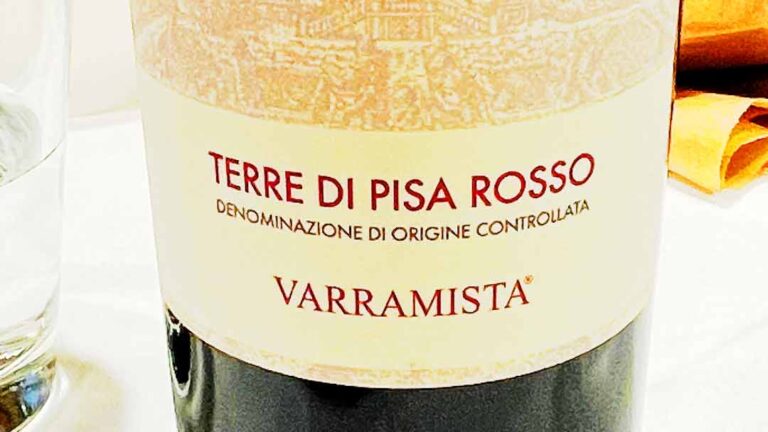“Are we in Iraq?”, asks a fellow traveller, looking out the car window. “I think it looks like Tunisia,” says another. “Are we in the right place?”, asks number three. Yes, we are in the right place. We are on the island of Pantelleria. A drop of soil of sixteen times eight kilometres and we begin to understand that nothing is as we imagined it would be. The drop Pantelleria is also a source of one of Italy’s most remarkable wines, Passito di Pantelleria. BKWine Magazine’s Asa Johansson tells about a fascinating journey.
I was expecting Pantelleria to be a Capri-like island with charming fishing villages, pastel-coloured houses and nice beaches. This vision was quickly obliterated when we see the steep cliffs falling down to the dark Mediterranean. Fishing villages there are none. Here you live from agriculture. Population, we are told, had to move inland, away from the coast to avoid the pirates who ravaged around Pantelleria once.
Traditionally they lived in so-called dammusi. It’s Hobbit-like low houses built of volcanic rocks with wave-shaped roof. The roof is designed to collect the valuable rain water in the water tanks. Some of these dammusi have been converted to luxurious summer homes. For example, the fashion designer Giorgio Armani has on of his summer homes on the island.
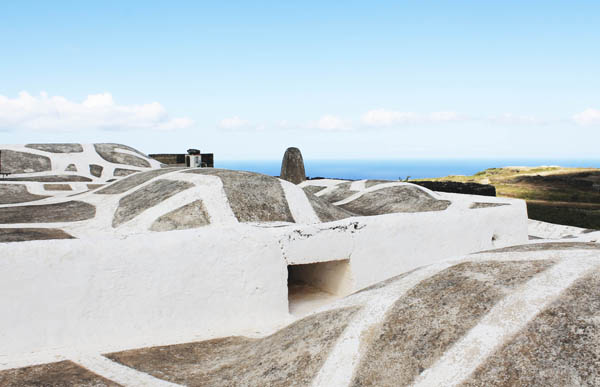
Pastel-coloured houses, there is not. In addition to the traditional dammusi the small villages are made up of of box-shaped houses with white peeling paint reminiscent of north African villages. Or possibly Iraq. As my first companion ironically pointed out.
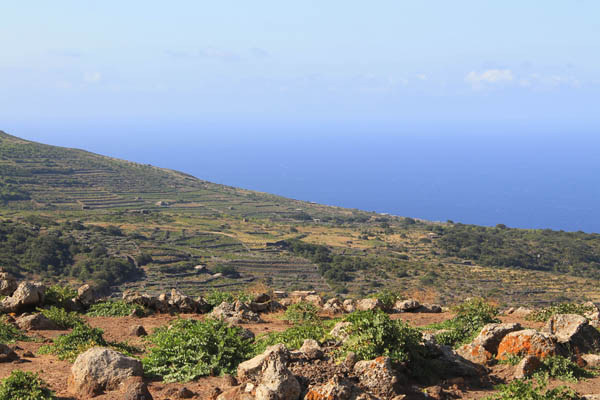
Passito di Pantelleria
But on Pantelleria they make one of Italy’s finest dessert wines: Passito di Pantelleria. It is a dessert wine ranging in colour from golden to dark amber. Put your nose in a glass of Passito di Pantelleria and feel the aromas of dried fig, peach, honey and apricot. In the more complex ones you will also find thyme, dates and wild herbs.
Passito di Pantelleria made from the zibibbo grape. It was probably the Romans who brought the zibibbo grape to Pantelleria, from Egypt. But there is disagreement on the grape’s origin. Ian d’Agata writes in his book “Native Wine Grapes from Italy” that some researchers believe that the grape’s origin is Sicily or Greece. He also writes that some researchers believe that zibibbo is a cross between moscato bianco and axina de tres bias. Another version is that it is a crossing between moscato bianco and black morocco.
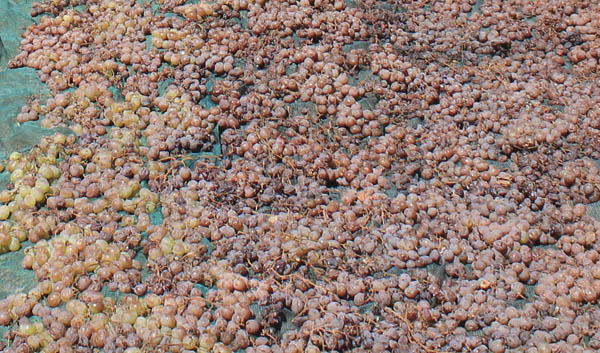
It is in any case agreed that it was the Arabs who began to dry the grapes. The name Zibibbo comes from the Arabic word zibib that means raisin. The official name is otherwise moscato d’alessandria and the grape belongs to the large muscat family. Zibibbo has large compact bunches.
The grapes are also larger and juicier than for example moscato bianco. Zibibbo has a thick skin and compared to other types of moscato zibibbo can withstand both heat and strong winds. Something that is necessary on Pantelleria! It is, however, sensitive to oidium. The total area of zibibbo plantations on Pantelleria is between 600 and 800 hectares.
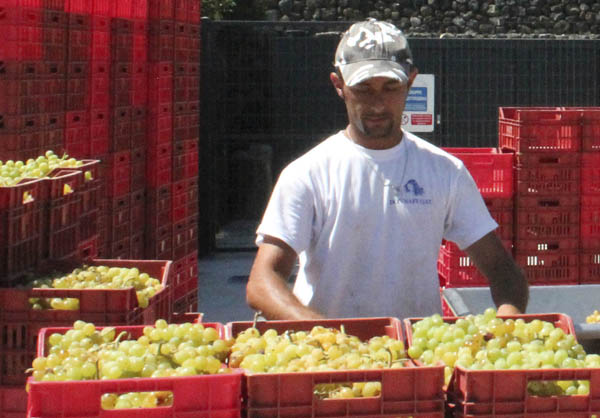
“Previously, there were about 6000 hectares of vineyards when zibibbo was sold as a table grape. Most of the island lived from the production of table grapes, until seedless grapes became popular”, says Fabrizio Basile from the Cantina Basile winery.
The daughter of the wind
The name Pantelleria comes from the Arabic bent-el rhia. The daughter of the wind. A suitable name you realise after a while. The wind blows. All the time. But it is not just the name of the island that has been marked by the wind. For example, the olive trees growing on the island are small half-meter-high bushes. One can hardly believe that they are olive trees. They bend with the wind and seek refuge in the black volcanic soil.
Lemon and orange trees do not manage the strong wind. To protect the precious fruit high circular walls around the trees were traditionally built. A circular room, a fruit tree and the blue sky as a roof. It is a mysterious and reverential feeling one is filled with walking into a giardino pantesco. Here man has understood the importance of protecting what nature provides.
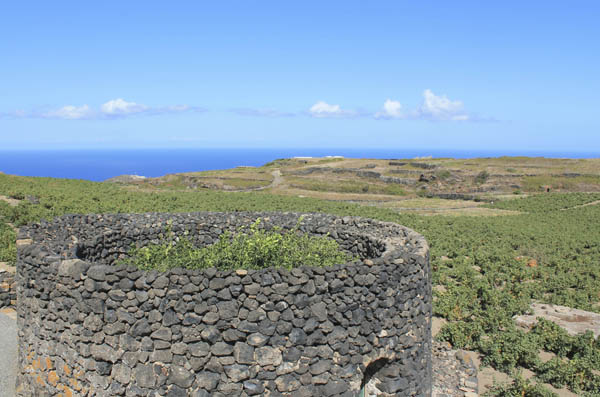
Alberello di Pantelleria, part of the UNESCO World Heritage
The zibibbo grapes grow on vines pruned as small bushes, a method called alberello in Italian (gobelet / bush vines). Pantelleria’s alberello vines were put on the UNESCO World Heritage List in November 2014. The island’s politicians hope that this will increase the attractiveness of Pantelleria and increase the number of tourists who come to this not very easily accessible island.
The zibibbo vineyards are located on steep terraces built of volcanic rocks. The dark blue Mediterranean that stretches endless towards the horizon is a constant background. The scenery is incredibly dramatic and feels inhospitable and seductive at the same time.
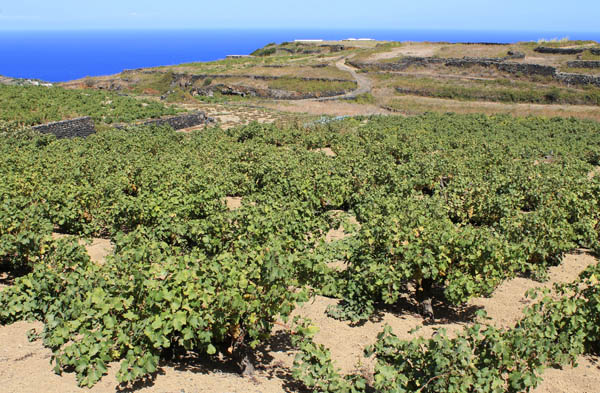
To protect the vines from the strong wind many farms have dug pits around the vines. But there are also other ways to protect the vines from the harsh wind.
“We are experimenting with protection built from bamboo which is put up in the vineyard when the wind blows too strongly”, says José Rallo, from the wine producer Donna Fugata.
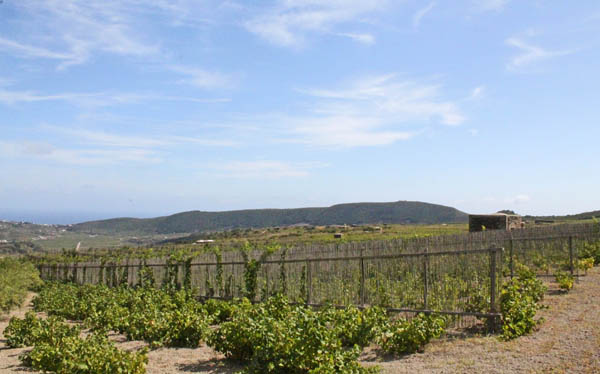
Zibibbo tanning without sunscreen
It’s not just the wind that causes many extra hours of work in the fields. To make Passito di Pantelleria the grapes are dried for around thirty days prior to being pressed. It is often not the whole bunches but just the individual grapes. To avoid that the grapes break destemming is made by hand. Obviously, harvest is also done by hand.
There are three methods to dry grapes. The most common is to allow the grapes to dry on straw mats attached to rectangular wooden frames. These need to be turned now and then to assure even drying.
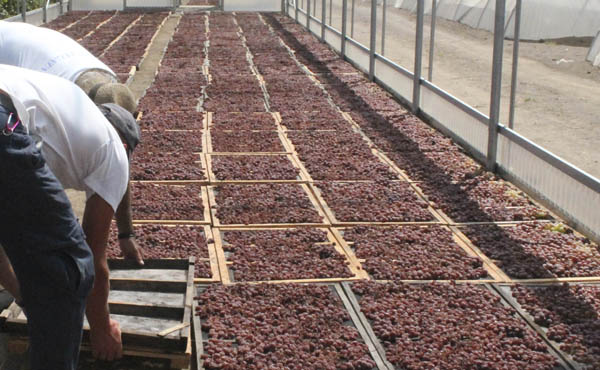
“We also have plastic roofs as we flip up during the night to avoid moisture that sometimes comes up to ninety percent”, says José Rallo at Donna Fugata.
The more traditional way to dry the grapes is to put them directly in the vineyard. Nowadays you put them on plastic mats or nets, and not directly on the ground. In some places they still put grapes on a bed of hay on the ground. And then the grapes are turned by hand, grape by grape, so that they all get an equal amount of sun.
“We put the grapes near a stone wall that protects against wind and that makes it really hot,” said Fabrizio Basile from the farm Cantina Basile.
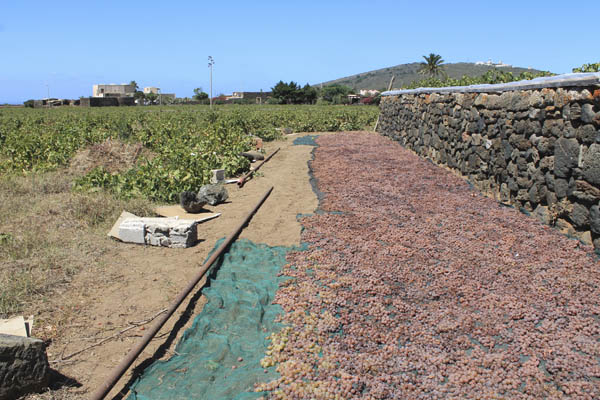
At the Pellegrino winery the instead put the grapes in a drying room with large fans.
“Drying our grapes in this way is not something that we try and hide. We simply think that this is the most secure and reliable way of working”, says winemaker Enea Poma.
The dried grapes lose up to fifty percent of their liquid. They are then mixed with the must from grapes that have not been dried. So harvest is made twice. The first harvest of grapes, which is placed to dry, usually starts in mid-August. Harvest number two, which they press directly, then begins in early September.
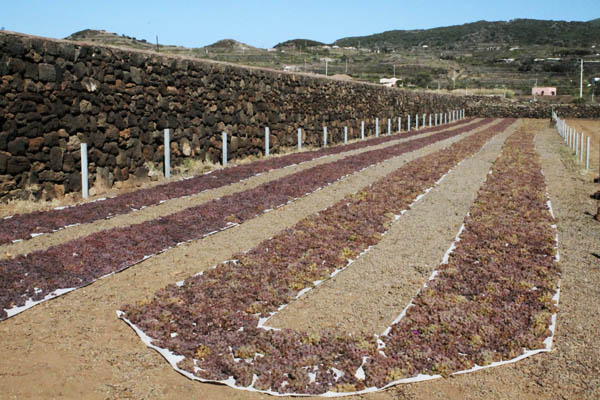
Each winery has its own “recipe” on the proportion of dried grapes mixed with the must from newly pressed grapes. In this way you will keep a freshness in the wines that balance all the sweetness. After maceration it is pressed a second time. Most producers then keep the wine in steel tanks before being bottled.
One of the few who keeps the Passito in the barrel is Sebastiano de Bartoli. He is the son of the late Marco de Bartoli, legendary producer of marsala. The winery’s name is Bukkuram. That means “the father of the vineyard” in Arabic and comes from the contrada where they Bartoli vineyards lie.
“I age my two passito wines, Il Sole di Agosto and Bukkaram Padre della Vigna, in barrels. The wines develop best that way, according to me, and become more complex”, said Sebastiano.
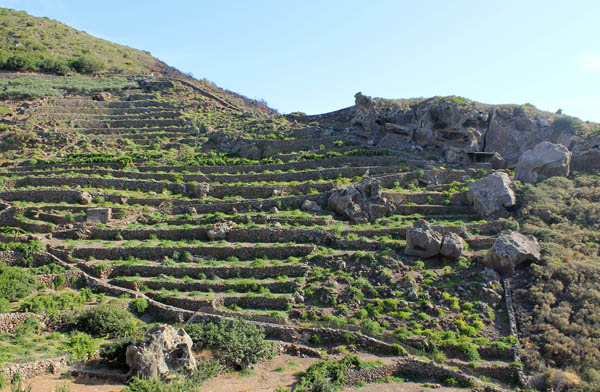
“Pantelleria is generous but chooses its guests carefully”
Pantelleria is not just a drop in the Mediterranean but also in the big wild world of wine. But just imagine how many nuances, aromas and stories such a small drop can contain. Pantelleria surprises and confirm. Welcomes and separates. An island full of contradictions.
Surprisingly, many of the Passito di Pantelleria wines that I try are elegant and with a good acidity. Some of the wines are, however, still a bit tired and are too sweet. At least for my own personal taste.
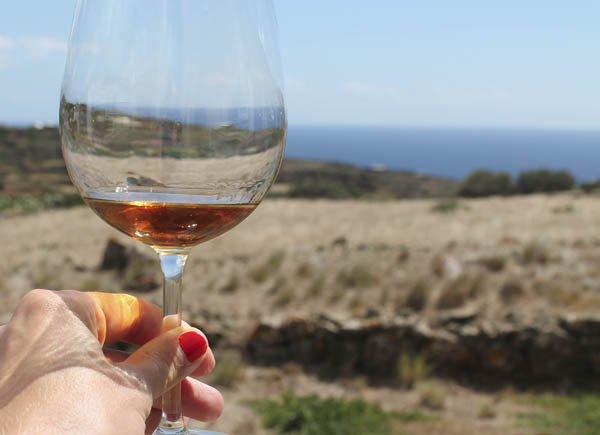
If you do not have the opportunity to go to Pantelleria, which is definitely worth a visit, you can still experience this strange and fantastic island in a glass of Passito di Pantelleria. In Italy we sometimes end a dinner or a long Sunday lunche with a glass of Passito di Pantelleria. Instead of dessert. Especially during the winter it can be delicious to drink a glass that makes you think of sunnier climes. Maybe you will even get a little wind in the hair too. You never know quite what the daughter of the wind may be doing.
Favourite Producers in Pantelleria
Donna Fugata
The Rallo family that owns Donna Fugata was one of the very first to believe in the potential of Pantelleria. They were already an established producer of marsala in Sicily. On Pantelleria they today have 68 hectares of vineyards. 2010 they planted a new experimental vineyard of 0.6 hectares with 33 different clones of zibibbo.
“Together with Professor Attilio Scienza from the University of Milan, we want to cross the different clones to produce stronger vines with zibibbo,” said Antonio Rallo.
Donna Fugata makes two different dessert wines: Kabir is a golden-coloured well-balanced Moscato di Pantelleria with aromas of dried apricot and fig. Just a notch higher is Donna Fugata’s Passito di Pantelleria Ben Ryé which more or less is a cult wine in Italy. It is a meditation wine, which soothes even the most troubled souls. To try!
Donnafugata, tel. +39 0923 724 244, www.donnafugata.it.
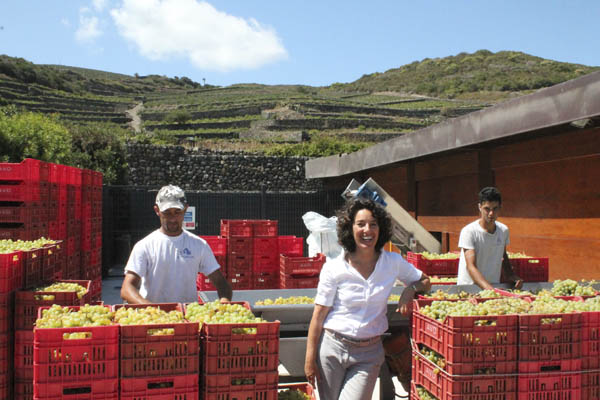
Cantina Basile
Fabrizio Basile left his job as a police officer in Rome in 2006 and moved back home to Pantelleria. Now he runs Cantina Basile with his wife Simona. They have a total of 6 hectares of which 3.2 hectares with zibibbo. The rest are red grapes. “We sell most of our production of 18,000 (half) bottles in the summer through direct sales at the winery”, says Fabrizio. Fabrizio’s Passito di Pantelleria Shamira is a golden yellow, apricot-scented wine with flavours of sun. A perfect ending to an extended dinner, instead of dessert.
Cantina Basile, ph. +39 0923 917205, www.cantinabasile.com
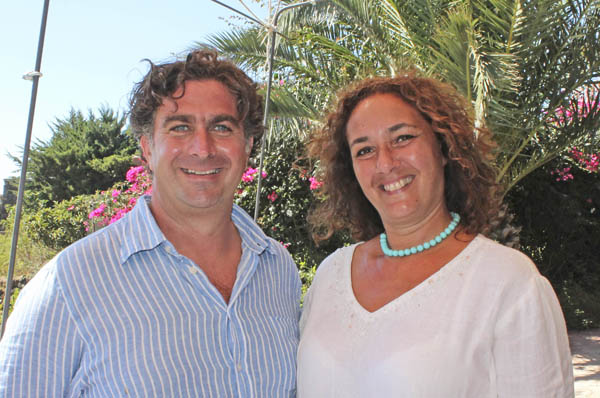
Dietro l’Isola
Salvino Gorgone who owns the vineyard is so nervous when we arrive that he barely gets a word out. “Salvino’s not so used to having journalists on a visit and he most enjoys being out in the vineyard”, said Donato Lonati, oenologist at the winery and one of Italy’s most famous wine profiles. Donato Lonati is also a professor of oenology at the University of Turin.
Salvino Gorgone used to grow capers but when the caper plants were completely destroyed after an insect attack he changed crop and planted zibibbo instead. On his 3.5 hectares he makes every year some 10,000 (half) bottles of Passito di Pantelleria Dietro l’Isola. The name means “behind the island”. The vineyard is located on the southern part of Pantelleria. The wine is stylish with crisp straight aromas and a good acidity.
Dietro l’Isola, ph. +39 0923.916203, www.passitodietrolisola.it
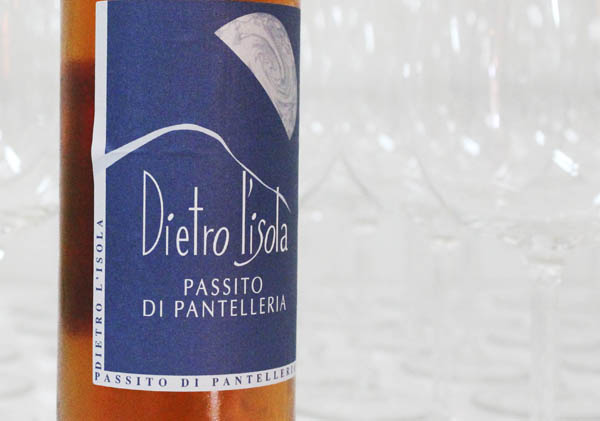
de Bartoli, Contrada Bukkuram
Sebastiano de Bartoli, a young man, in his thirties, runs the De Bartoli vineyards on Pantelleria since his father’s death. No easy task, given that the father, Marco de Bartoli, was one of the most prominent personalities in Italy in wine. The de Bartoli wines from Marsala are still some of the most sought after.
A premonition of what pressure it must be during the harvest is all the sculptures that are scattered inside the storage room. “Every year when the harvest is over I make a statue. That’s probably why the sculptures always look so worried”, said Sebastiano, smiling.
But Sebastiano with his reclusive yet charismatic personality seems to have most things under control. So it seems, at least, when we taste the wines. Il Sole di Agosto and Bukkuram Il Padre della Vigna are wines you will not forget in a hurry.
de Bartoli, ph. +39 0923.918344, www.marcodebartoli.com
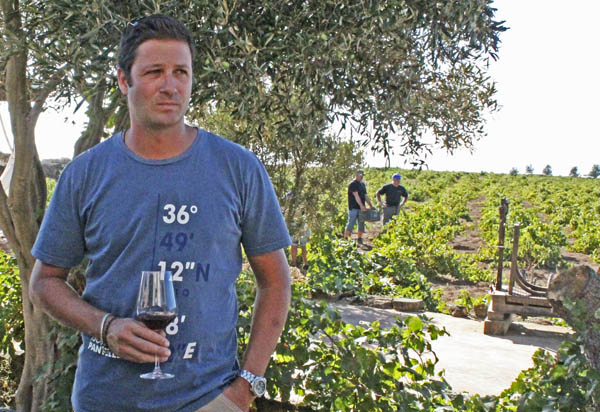
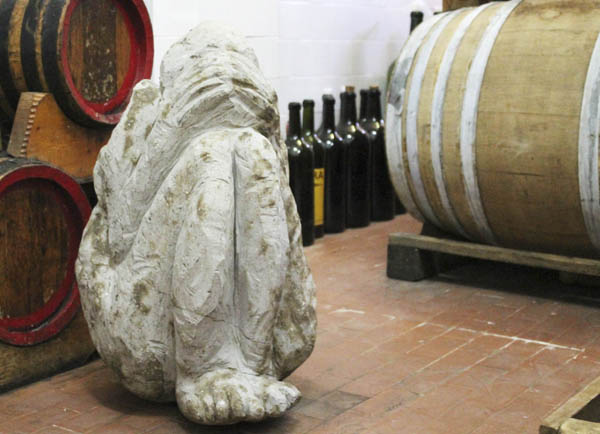
Asa travelled to Pantelleria as an invited journalist and wine writer.
Åsa Johansson is BKWine’s person in Italy. She lives in Florence since the early ’00s. She has a passion for all things Italian, so much so that she married an Italian and stayed in Florence after having come there to study political science.
